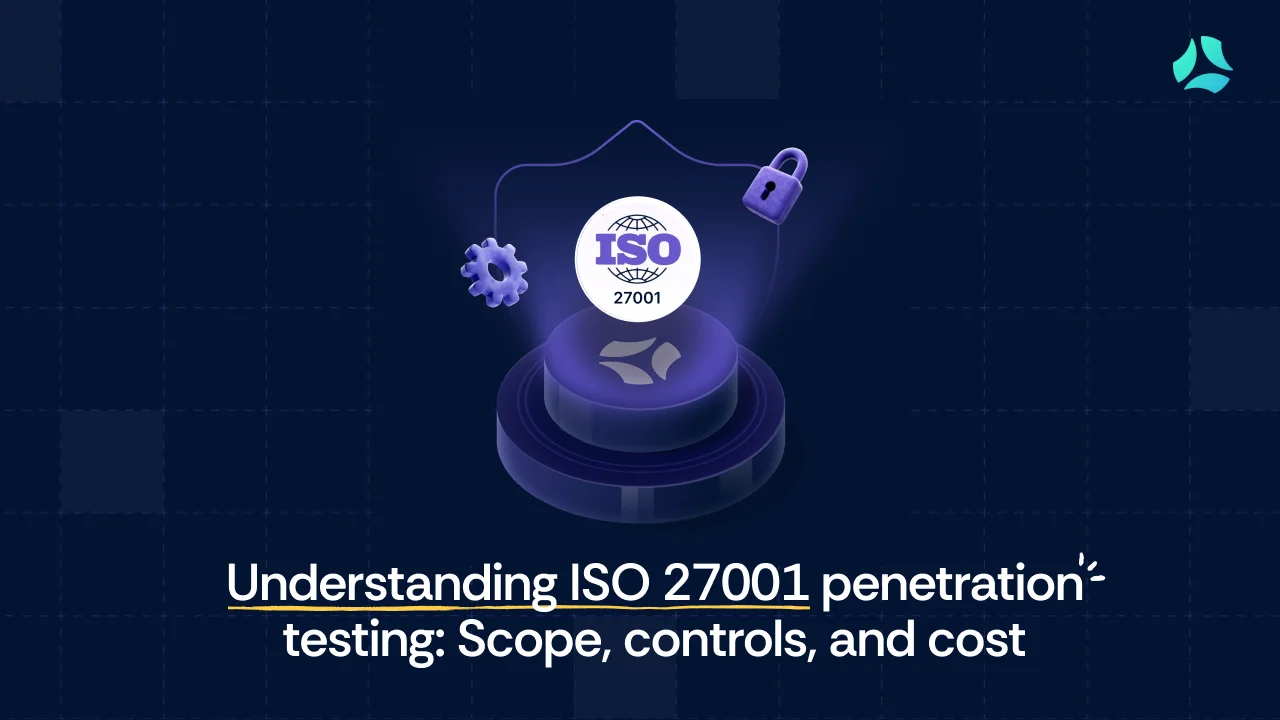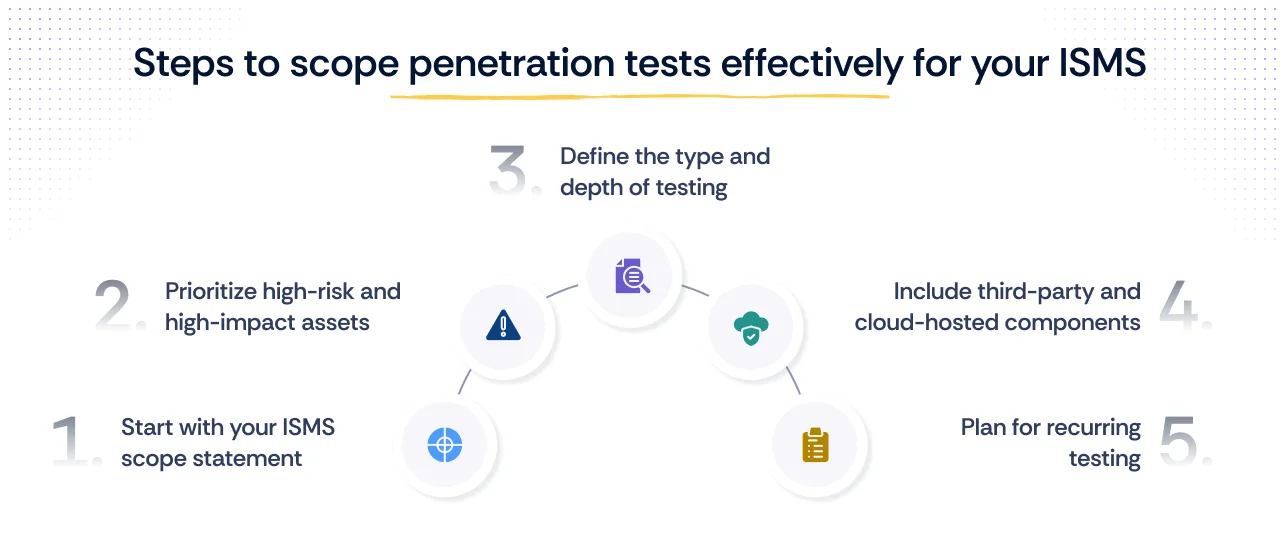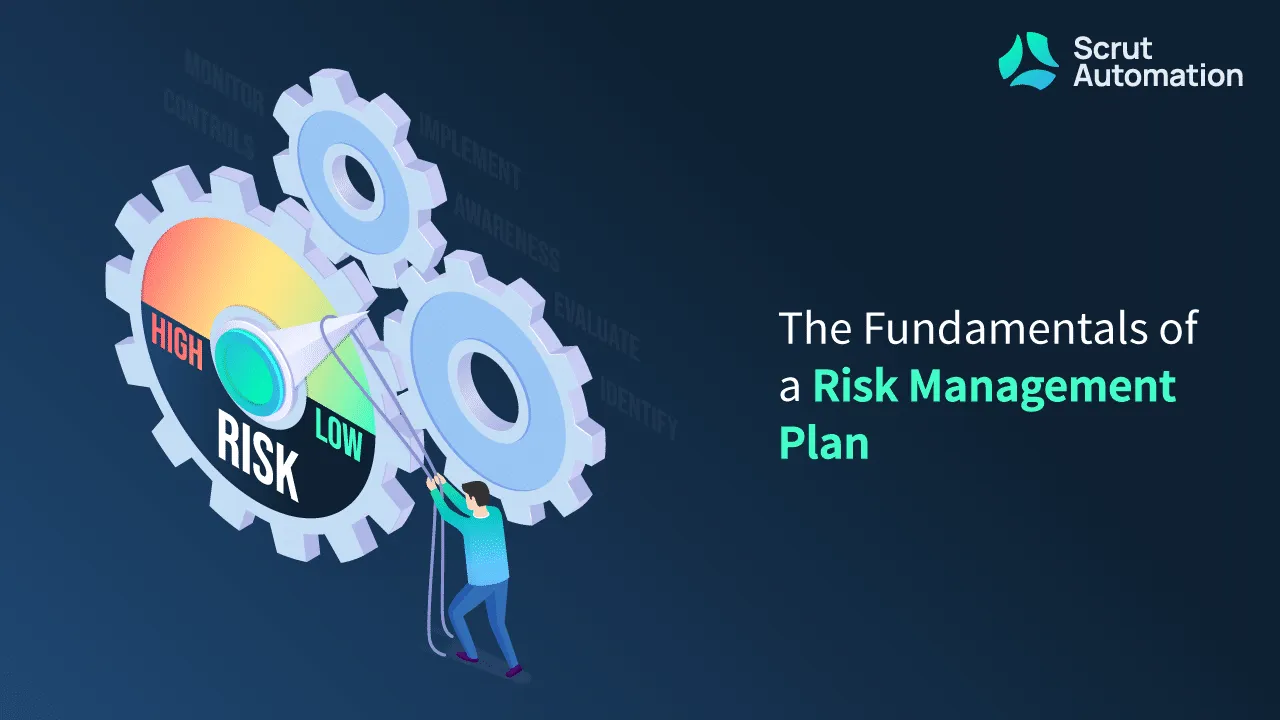ISO 27001 Penetration testing: Controls, frequency, and methodologies

You can lock the doors, bolt the windows, and set up alarms, but if you never test your defenses, how will you know they actually work?
That’s the gap penetration testing fills in your ISO 27001 compliance journey. It doesn’t just show you where you think you’re secure; it shows you where you’re not. And for compliance-conscious companies, that’s a critical distinction.
While ISO 27001 doesn’t explicitly mandate pen testing, it expects you to understand and address your technical vulnerabilities. Think of it like this: the standard gives you the blueprint for a secure fortress, but pen testing is the stress test that tells you whether the walls can really withstand an attack.
In this blog, we’ll peel back the layers on what ISO 27001 expects around penetration testing, the relevant controls, how to implement it, and how it all ties back to audit readiness.
What is ISO 27001 penetration testing?
Penetration testing is a controlled security assessment where ethical hackers simulate real-world attacks to identify and exploit vulnerabilities in an organization’s systems, networks, or applications. The objective is to understand how an attacker could gain unauthorized access to sensitive data or disrupt operations.
Within the ISO 27001 standard, penetration testing serves as a practical method to evaluate whether your technical controls are effective. It moves beyond policy documentation to test actual implementation, helping organizations uncover blind spots that may not surface during a risk assessment or vulnerability scan.
Unlike automated vulnerability scans, which flag known issues, penetration tests involve manual techniques and creative exploitation to mimic how a real attacker might behave. For example, testers may chain low-risk issues together to escalate privileges, move laterally across systems, or extract sensitive information.
Penetration testing is not explicitly required by ISO 27001, but it plays a critical role in supporting several key control objectives. It helps validate your risk treatment decisions, contributes to your Statement of Applicability, and provides clear, actionable evidence for internal reviews and certification audits.
In short, penetration testing helps you move from assumptions to assurance. It brings your security program into focus by showing whether your defenses can actually hold up under pressure.
Is penetration testing mandatory for ISO 27001 compliance?
No, penetration testing is not explicitly mandatory for ISO 27001 certification.
However, it is strongly recommended. While the standard does not specifically require pen tests, it expects you to identify, assess, and treat technical vulnerabilities as part of your ISO 27001 risk management process. Penetration testing is one of the most effective ways to meet that expectation.
Which ISO 27001:2022 controls address penetration testing?
ISO 27001 doesn’t explicitly mention “penetration testing,” but several controls within Annex A directly support or benefit from it, especially under the 2022 revision. Penetration testing helps fulfill the intent behind these controls by offering real-world validation of your technical and operational defenses.
Here are the key ISO 27001:2022 controls where penetration testing plays a role:
A.5.25 – Assessment and decision on information security events
This control expects you to analyze and act on indicators of potential compromise. Penetration testing simulates realistic attack paths, helping you anticipate and assess what kinds of events would be most damaging, and whether your detection mechanisms are working.
A.5.23 – Information security for use of cloud services
Cloud environments are dynamic and prone to misconfigurations. Penetration testing helps ensure that cloud assets, including storage, identity configurations, and APIs, are not only protected by policy but resilient in practice.
A5.19 to A.5.22 – Supplier and third-party security
This range of controls covers supplier relationships, contractual security requirements, ICT supply chain, and ongoing monitoring. Pen testing of third-party integrations or vendor systems helps validate these controls.
A.8.8 – Management of technical vulnerabilities
This control, carried over from ISO 27001:2013, focuses on identifying and mitigating vulnerabilities. Pen testing supports this by uncovering both known and unknown issues, and by providing evidence that remediation has been prioritized and completed.
A.8.16 – Monitoring activities
Although this control focuses more on logging and monitoring, pen testing helps you evaluate how effective your monitoring really is. Can your SIEM detect the activity simulated by a red team engagement? Can alerts be triggered in time?
A.8.29 – Security testing in development and acceptance
This control requires security testing during development and before release. Penetration testing, especially targeted or white-box tests, helps fulfill this for SaaS products and internal tools handling sensitive data.
Why penetration testing is still strongly recommended for ISO 27001
While ISO 27001 doesn’t explicitly require penetration testing, the previous section explained that the standard expects you to identify, assess, and treat technical vulnerabilities and to do so as part of a structured, risk-based approach. That expectation stems directly from Clause 6.1.2, which outlines how organizations must assess and treat risks systematically.
Penetration testing is one of the clearest ways to meet that expectation. It simulates real-world attacks, uncovering not just known vulnerabilities but also complex logic flaws, chained exploits, and risky misconfigurations (the kind that often fly under the radar in routine scans).
Here’s why it’s widely recommended, even if not mandated:

1. Strengthens your risk treatment plan
Penetration test results feed directly into your risk register and Statement of Applicability (SoA). This makes them incredibly useful for prioritizing risk treatment based on actual exploitability, not just theoretical severity.
2. Validates the effectiveness of ISO 27001 controls
Controls like A.8.8 (technical vulnerability management) and A.5.25 (assessment of security events) are outcome-driven. Pen testing provides real evidence that your controls are not just implemented, but functioning effectively in a live environment.
3. Supports a risk-based approach under Clause 6.1.2
ISO 27001 requires that risks be identified, analyzed, and treated systematically. Pen testing helps fulfill this requirement by identifying risks that scanners, self-assessments, or checklists may overlook, especially risks introduced by evolving cloud environments or complex third-party integrations.
4. Prepares you for auditor's expectations
While not formally required, some ISO 27001 auditors, particularly those reviewing high-risk or cloud-native environments, may ask to see recent pen test results. Having this evidence on hand demonstrates maturity and saves time during audit reviews.
5. Improves trust with customers and stakeholders
Most security-conscious clients know that ISO 27001 certification alone doesn’t mean invulnerable systems. A recent, well-scoped penetration test shows that you take threat validation seriously, not just compliance.
Pen testing is what brings your ISO 27001 controls to life. It shows that you're not just managing paperwork, but actively measuring resilience, and that makes all the difference.
What are the recommended penetration testing methodologies for ISO 27001?
ISO 27001 doesn’t prescribe a specific methodology for penetration testing. However, to ensure consistency, credibility, and audit readiness, organizations are expected to follow established industry standards that demonstrate a structured and repeatable approach.
Here are the most commonly recommended methodologies:
1. OWASP Web Security Testing Guide
For organizations with internet-facing apps, the OWASP Web Security Testing Guide is a go-to framework. It covers everything from input validation and authentication flaws to business logic testing and access control failures. It’s especially helpful when testing SaaS platforms or customer portals as part of your ISO 27001 scope.
2. NIST SP 800-115 (Technical Guide to Information Security Testing and Assessment)
This is a comprehensive guide from the National Institute of Standards and Technology that outlines how to plan, execute, and report on penetration tests. It’s particularly useful for internal testing teams that want a formal process for testing and post-test remediation planning.
3. OSSTMM (Open Source Security Testing Methodology Manual)
Developed by ISECOM, OSSTMM focuses on measuring operational security across digital and physical environments. It's ideal for organizations that want a broader, risk-based view of their technical and organizational controls under ISO 27001.
4. PTES (Penetration Testing Execution Standard)
PTES is a flexible and widely adopted framework for network and infrastructure penetration testing. It guides testers through phases like reconnaissance, threat modeling, exploitation, and reporting, all of which tie back neatly to ISO 27001’s emphasis on documenting risk treatment activities.
5. CREST and CHECK methodologies (for regulated industries)
In high-regulation sectors or when operating under government contracts, some organizations may opt for CREST-certified pen testers or follow frameworks like the UK’s CHECK methodology. These bring third-party validation and added assurance when certification bodies or clients expect rigorous assessments.
How these methodologies support ISO 27001
All of these frameworks help you generate consistent, repeatable test results. More importantly, they produce structured reports that support your ISO 27001 risk assessments, risk treatment plans, and audit evidence.
Following a recognized methodology shows that your organization isn’t just running tests for the sake of it; you’re aligning your testing strategy with best practices and ensuring findings can be clearly tied back to ISO 27001 controls.
If you're engaging an external vendor, make sure they reference one or more of these methodologies in their statement of work. And if you're testing internally, adopting one of these frameworks helps ensure your results hold up to scrutiny, whether from your own leadership or from an external auditor.
How to scope penetration tests effectively for your ISMS
Scoping a penetration test for ISO 27001 isn’t just about picking random systems and seeing what breaks. It’s about aligning the test with the boundaries of your Information Security Management System (ISMS), identifying high-risk assets, and making sure the results provide meaningful insights for your risk treatment and audit preparation.
Here’s how to get the scope right:

1. Start with your ISMS scope statement
Your ISO 27001 scope statement defines the boundaries of your ISMS; in other words, which systems, departments, locations, and processes are covered by your certification efforts. The penetration test should cover assets and infrastructure that fall within this scope.
If your ISMS covers your production cloud environment, for example, excluding that from a pen test would create a major blind spot and raise questions during the audit.
2. Prioritize high-risk and high-impact assets
Not every asset needs to be tested equally. Focus on components that handle sensitive data, manage access, or are exposed to the internet. This could include:
- Public-facing web applications
- Cloud infrastructure (e.g., AWS, GCP, Azure)
- APIs and microservices
- Authentication and access control systems
- Critical internal tools with privileged access
Your risk register should guide you here. Systems with high inherent risk or a history of misconfigurations are prime candidates.
3. Define the type and depth of testing
Based on your risk appetite and available resources, choose the appropriate testing approach:
- Black box: Testers have no internal knowledge. Ideal for simulating an external attacker.
- White box: Full knowledge of architecture and source code. Useful for detailed validation.
- Gray box: Partial knowledge (e.g., internal credentials). Balances realism and efficiency.
For ISO 27001, gray box testing is often preferred as it reflects an attacker with insider knowledge or credentials compromised via phishing or vendor breach.
4. Include third-party and cloud-hosted components
Many compliance gaps stem from vendor connections or misconfigured cloud services. If you rely on SaaS tools or have third-party integrations within your ISMS scope, those should be part of the testing plan too.
Keep in mind: ISO 27001 Annex A.5.22 (monitoring, review, and change management of supplier services) and A.5.23 (Information security for use of cloud services.) both emphasize the importance of validating external dependencies.
5. Plan for recurring testing
Scoping isn’t a one-time exercise. Your tech stack, threat landscape, and compliance posture will evolve. Make sure your penetration test scope is revisited at least annually or after major changes, such as new app launches, cloud migrations, or significant codebase updates.
How much does a penetration test cost for ISO 27001?
Penetration testing tailored for ISO 27001 compliance generally costs between USD 5,000 and USD 20,000, depending on factors like scope, testing depth, and provider reputation. For the full cost breakdown of ISO 27001 certification, including audits, consultancy, and internal resources.
Pro tip: Pen testing is a periodic cost; remediation is not
Don’t forget to budget for fixing the findings. A penetration test is only valuable if the issues it uncovers are addressed. Some organizations also run a retest after remediation, which may come at a discounted rate if scoped in advance.
The State of Pentesting Report 2025 confirms that less than half (48%) of all findings are addressed, and 31% of the riskiest findings never get resolved, leaving the vulnerabilities wide open for cyber criminals.
How often should you perform an ISO 27001 penetration test?
ISO 27001 doesn’t set a fixed frequency, but annual pen tests are best practice. Test after major changes, critical fixes, or when risk assessments show increased exposure to keep defenses aligned with your environment and control requirements.
What are some popular vendors for ISO 27001 pen test services?
When choosing a vendor for ISO 27001-related penetration testing, it’s important to work with firms that understand not just offensive security, but also how their findings map to compliance controls and audit evidence. Here are some widely recognized players in the space:
- Cobalt
- NetSPI
- Pentest People
- Secureworks
Can a pen test be automated for the organization?
Yes, penetration testing can be partially automated, but not fully.
Automated tools are useful for scanning known vulnerabilities and misconfigurations, especially in cloud environments. However, they can’t detect complex, context-specific issues like logic flaws or chained exploits. For ISO 27001, automation supports ongoing testing, but manual expertise is still essential for depth and audit readiness.
Is ISO 27001 penetration testing different in modern environments?
Yes, penetration testing varies based on the environment being tested, and ISO 27001 expects you to account for these differences.
In cloud environments, the focus is often on misconfigured services, exposed storage buckets, and overly permissive IAM roles. In containerized or microservices-based systems, testing targets inter-service communication, API authentication, and container escape risks. For SaaS platforms or third-party integrations, pen testing involves validating how external connections impact your security posture.
While the core goal remains the same, to identify exploitable vulnerabilities, the testing methods, tools, and scope must adapt to the underlying architecture. ISO 27001:2022 controls like A.5.23 (cloud services) and A.5.22 (third-party security) highlight this shift. A one-size-fits-all test won’t cut it. Your pen test should reflect the specific risks of the modern stack you're operating in.
Need help testing what matters most?
Scrut works with certified penetration testing partners and maps findings directly to ISO 27001:2022 controls, from cloud misconfigurations to third-party risks.
FAQs
What is the frequency for ISO 27001 penetration testing?
ISO 27001 doesn’t mandate a set frequency, but annual testing is widely recommended. Run tests after major changes, critical fixes, or when risk assessments show higher exposure. Some organizations also re-test to confirm remediation. Frequency should match your environment’s pace of change and risk level.
Can vulnerability scanning replace penetration testing for compliance?
No, vulnerability scanning cannot replace penetration testing for ISO 27001 compliance. Scans detect known issues but don’t exploit them or assess real-world impact. Pen testing simulates attacks, uncovers complex flaws, and validates control effectiveness. Both are essential, scanning for ongoing vulnerability management (A.5.36) and pen testing for stronger audit evidence.
What does a typical penetration testing report include for an ISO 27001 audit?
A standard pen test report for ISO 27001 should include:
- Executive summary with key findings and business impact
- Scope and methodology, including what was tested and how
- Detailed findings with severity ratings and exploitation evidence
- Remediation recommendations, ideally mapped to ISO controls
- Retesting results, if follow-up testing was done
The report should show that testing was thorough, risk-based, and aligned with ISO 27001 expectations, especially for controls like A.5.36 and A.8.29.
Does Penetration Testing help to find vulnerabilities?
Yes, penetration testing helps identify vulnerabilities and show how they could be exploited in real-world scenarios. It simulates attacks to uncover misconfigurations, logic flaws, and chained exploits, validating both the existence and impact of weaknesses, essential for prioritizing risk treatment under ISO 27001.
Should I perform penetration testing and vulnerability scanning as part of my ISO 27001 audit?
Yes, you should perform both. Vulnerability scanning offers broad, automated detection of known issues, supporting ongoing management under Control A.5.36. Penetration testing simulates real attacks to validate exploitability and control effectiveness. Together, they provide complementary evidence for risk assessments, treatment plans, and audit readiness.


















